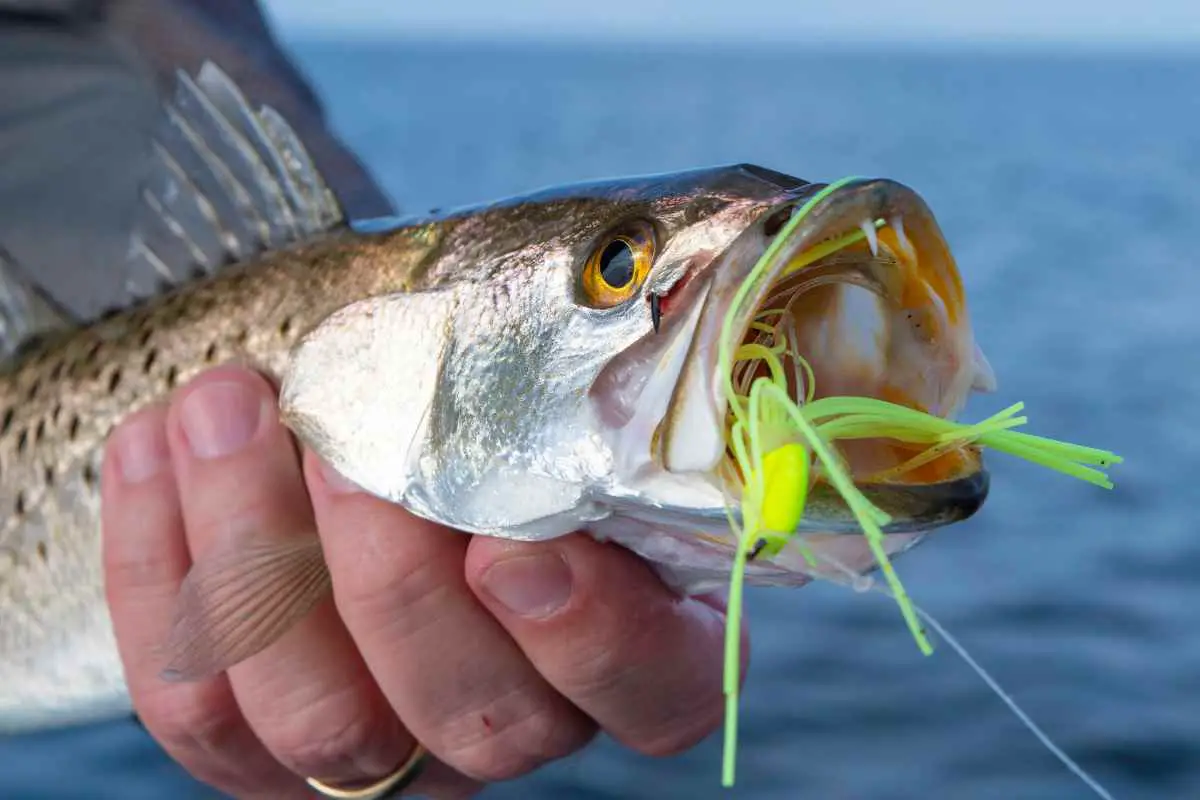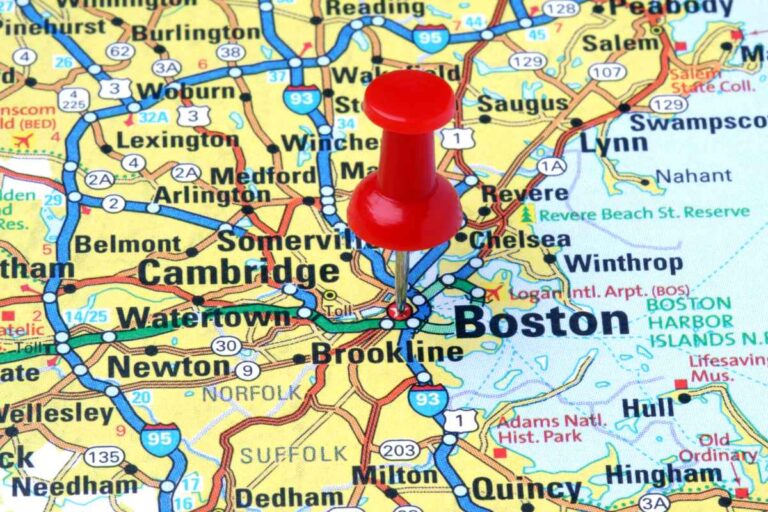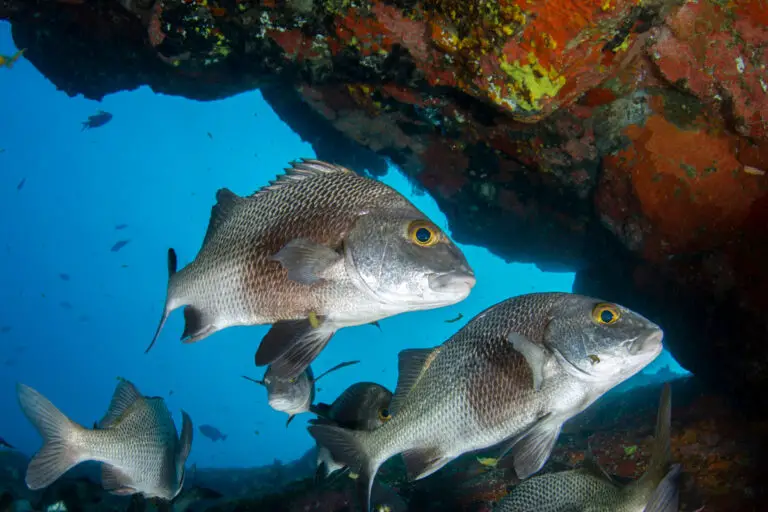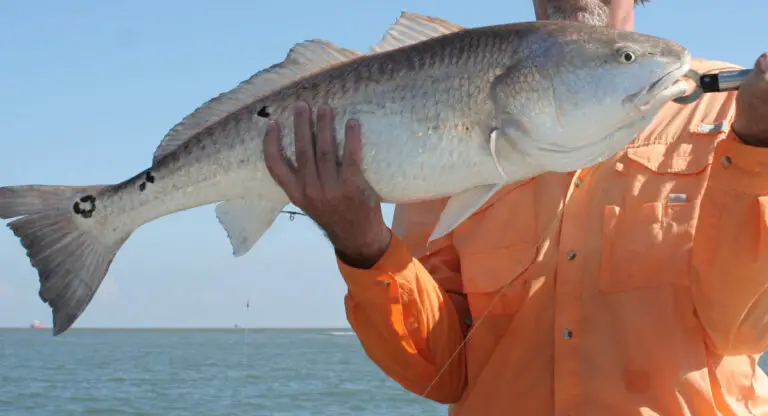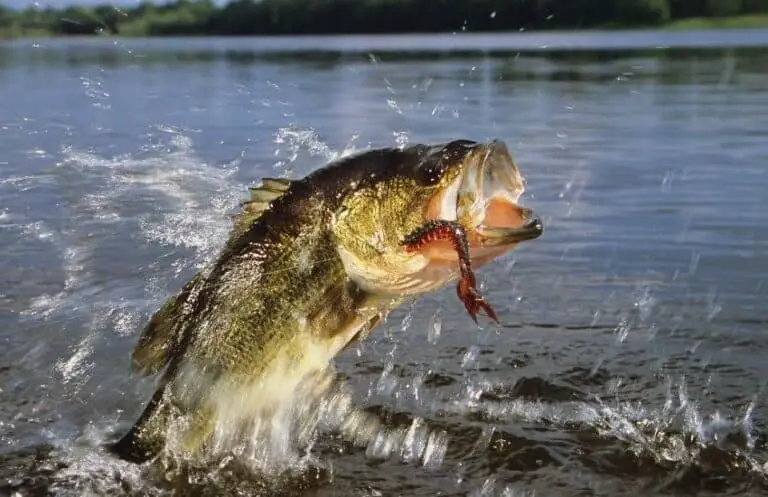Virginia Saltwater Fishing Size Limits [2023]: Top 37 Game Fish
Estimated reading time: 13 minutes
If you plan a saltwater fishing trip in Virginia, it’s important to know the state’s fishing regulations and size limits to avoid legal issues. Below is the most common Virginia saltwater fish size limits for 30 popular game fish:
- Striped bass: 20-inch or 28-inch minimum size limit (depending on location and season), possession limit of 1 fish per person per day
- Summer Flounder: 16-inch minimum size limit, possession limit of 4 fish per person per day
- Red drum: 18 inches minimum size limit, possession limit of 3 fish per person per day
- Black sea bass: 13-inch minimum size limit, possession limit of 15 fish per person per day during open season
- Spotted sea trout: 14 inches minimum size limit, possession limit of 5 fish per person per day, including 1 greater than 24 inches
It’s essential to check the Virginia Marine Resources Commission website for the most up-to-date and specific size and possession limits for the species you are targeting, as they can change from year to year.
By following these regulations, you can help maintain the sustainability of fish populations and ensure a healthy marine environment.
Virginia Saltwater Fish Limit Definitions
Saltwater fishing size limits are designed to maintain optimum yields for recreational anglers statewide. In Virginia saltwater fishing, bag limits are established and bagged by species and, in some cases, size restrictions.
Each is regulated and enforced by the Virginia Marine Resources Commission. Anglers are subject to fines for fishing and conservation violations.
- Bag limit – The maximum number of fish a person may catch in one day or per period. It’s usually limited to per person, per day, and on rare occasions, it includes a daily vessel limit.
- Creel limit – There is no difference between the bag and creel limits for Virginia fishing.
- Minimum size limit – The saltwater fishing regulations state that the fish must be larger than a certain size to be taken. These rules allow fish to reach a size where they can reproduce before being harvested.
- Slot limit – Slot limits are similar to the minimum size restriction in that there is both a maximum and minimum size limit and only fish that fit within the slot may be taken. This classification helps developing young fish mature while also shielding larger spawning fish.
- Season – Times of year open or closed to saltwater fishing for a certain species. A closed season protects fish from harvest during sensitive times of the year, such as spawning periods or heavy fishing.
Virginia Saltwater Fishing Size Limits
What are Virginia Saltwater Fishing Size Limits?
Saltwater fishing in Virginia requires knowledge of the state’s regulations, including the Virginia saltwater fishing size limits. These limits define the minimum and maximum sizes of fish that can be legally caught and kept. They aim to promote responsible fishing practices and protect fish populations. The Virginia Marine Resources Commission (VMRC) sets the size limits based on the fish species, location, and time of year.
Anglers should know the size limits for the species they want to catch and adhere to these regulations to avoid penalties and fines. Violating the size limits can result in legal consequences and harm the environment. It’s essential to stay informed by checking the VMRC website or Virginia Fishing Regulations Guide regularly for updates.
Virginia Saltwater Fish Size Limits: A Handy Quick Chart
| Species Name | Season Dates | Minimum Size Limit | Possession Limit | Capture Citation | Release Citation | State Record |
|---|---|---|---|---|---|---|
| Alewife | Illegal to possess | |||||
| Amberjack | 32 inches | 2 fish per person | Release only | 50 inches | 118 lbs, 1986, Mark J. Roberts | |
| American Eel | 9 inches | 25 fish per person | ||||
| Black Drum | 16 inches | 1 fish per person | 80 lbs | 46 inches | 111 lbs, 1973, Betty D. Hall | |
| Black Sea Bass | 13 inches | 15 fish per person | 5 lbs | Not eligible | 10 lbs 4 oz, 2000, Allen P. Paschall | |
| Blue Catfish | 32 inches | 1 fish per person | ||||
| Blueback Herring | Illegal to possess | |||||
| Bluefish | None | 3 fish per person from shore or private vessel; 5 per person on for-hire or charter vessels | 16 lbs | 36 inches | 25 lbs 4 oz, 1986, Gayle E. Cozzens | |
| Cobia | Open: Jun 15 – Sep 15 | 40 inches, 1 per vessel > 50 inches | 1 fish per person 2 per vessel whichever is more restrictive | 55 lbs | 50 inches | 109 lbs, 2006, Joseph F. Berberich, II |
| Crevelle Jack | Release only | 40 inches | 48 lbs 12 oz, 1993, Charles McCaskill, III | |||
| Croaker | None | 50 fish per person additional 50 live bait per customer capacity on for-hire or charter vessels | 3 lbs | 20 inches | 8 lbs 11 oz, 2007, Norman T. Jenkins | |
| Dolphin | 25 lbs | Not eligible | 71 lbs 8 oz, 1991, Don Dorey |
|||
| Grey Trout (Weakfish) | 12 inches | 1 fish per person | 9 lbs | 30 inches | 19 lbs, 1983, Philip W. Halstead | |
| Groupers | None | 1 fish per person | Snowy Grouper, 70 lbs 7 oz, 2011, Roger C. Burnley | |||
| King Mackerel | 27 inches | 3 fish per person | 20 lbs | Not eligible | 2 lbs 13 oz, 2002, Chip Watters | |
| Kingfish (Roundhead) | 1 lbs 8 oz | 16 inches | 63 lbs 1 oz, 2007, Susan M. Smith | |||
| Pompano | 1.5 lbs | 16 inches | 5 lbs 10 oz, 1992, Robert T. Long | |||
| Red Drum (Redfish, Channel Bass) | 18 – 26 inch slot size | 3 fish per person | Release only | 46 inches | 85 lbs 4 oz, 1981, Herman Moore | |
| Scup (Porgy) | 9 inches | 30 fish per person | 5 lbs 5 oz, 1978, Charles B. Haines, Sr. | |||
| Shad, American | Illegal to possess | |||||
| Sharks (All species except smooth and spiny dog sharks) | Open: May 15 – Jul 15 | 54 inches fork length | 1 fish per vessel | Release only | 72 inches | |
| Sheepshead | None | 4 fish per person | 10 lbs | 24 inches | 20 lbs 12 oz, 2005, Arun Nhek | |
| Spadfish | None | 4 fish per person | 8 lbs | 22 inches | 14 lbs 14 oz, 2009, Roland E. Murphy | |
| Spanish Mackerel | 14 inches | 15 fish per person | 4 lbs | 26 inches | 9 lbs 13 oz, 1993, Everett Cameron | |
| Speckled Trout (Spotted Seatrout) | 14 inches | 5 fish per person, 1 greater than 24 inches allowed | 5 lbs | 24 inches | 16 lbs, 1977, Bill Katko | |
| Spot | None | 50 fish per person, additional 50 live bait per customer on for-hire or charter vessels | 1 lbs | 13 inches | 2 lbs 6 oz, 1980, Nathan Dryden | |
| Striped Bass (Rockfish, Striped) | Virginia Coastal Seasons: Jan 1 – Mar 31 May 16 – Dec 31 | 28 – 36 inches slot size | 1 fish per person | 40 lbs | 44 inches | 74 lbs, 2012, Cary Wolfe |
| Striped Bass (Rockfish, Striped) | Cheseapeake Bay Spring Season: May 16 – Jun 15 | 20 – 28 inches slot size | 1 fish per person | 40 lbs | 44 inches | |
| Striped Bass (Rockfish, Striped) | Cheseapeake Bay Fall Season: Oct 4 – Dec 31 | 20 – 36 inches slot size | 1 fish per person | 40 lbs | 44 inches | |
| Sturgeon | Illegal to possess | |||||
| Summer Flounder | 16 inches | 4 fish per person | 6 lbs | 26 inches | 17 lbs 8 oz, 1971, Charles E. Cross | |
| Swordfish | 100 lbs | No Min | 446 lbs, 2012, Joseph T. Harris | |||
| Tautog | Closed: May 16 – Jun 30 | 16 inches | 4 fish per person | 9 lbs | 23 inches | 24 lbs 3 oz, 2012, Ken Neill, III |
| Tilefish, Blueline | Open: May 1 – Oct 31 | None | 10 lbs | Not Eligible | 23 lbs 5 oz, 2009, Michael Akins | |
| Tilefish, Golden | None | 8 fish per person | 30 lbs | Not Eligible | 56 lbs 8 oz, 2008, Aaron Sledd | |
| Tuna (Bluefin) | 100 lbs | 60 inches | 606 lbs, 2015, Chase Robinson | |||
| Tuna (Yellowfin, Bigeye) | 70 lbs | Not Eligible | Bigeye Tuna, 311 lbs, 2013, Vic Gaspeny Yellowfin Tuna, 203 lbs 12 oz, 1981, Bruce C Gottwald, Jr. |
|||
| Wahoo | 35 lbs | Not Eligible | 122 lbs 1 oz, 2012, Susan Nelson |
All Prohibited Fish Species
We have the list of prohibited species conveniently listed here for you. Possessing fish caught of these species is illegal, and harvesting these species is strictly prohibited. There are associated fines for violations.
- Atlantic angel, Squatina dumeril, Basking, Cetorhinus maximus, Bigeye sand tiger, Odontaspis noronhai, Bigeye sixgill, Hexanchus nakamurai, Bigeye thresher, Alopias superciliosus, Bignose, Carcharhinus altimus, Caribbean reef, Carcharhinus perezii, Caribbean sharpnose, Rhizoprionodon porosus, Dusky, Carcharhinus obscurus, Galapagos, Carcharhinus galapagensis, Longfin mako, Isurus paucus, Narrowtooth, Carcharhinus brachyurus, Night, Carcharhinus signatus, Sand tiger, Carcharias taurus, Sandbar, Carcharhinus plumbeus, Sevengill, Heptranchias perlo, Shortfin mako, Isurus oxyrinchus, Silky, Carcharhinus falciformis, Sixgill, Hexanchus griseus, Smalltail, Carcharhinus porosus, Whale, Rhincodon typus, White, Carcharodon carcharias.
- Daily Bag: 0, catch and release only; harvest prohibited.
How To Follow Virginia Saltwater Fishing Size Limits?
Virginia saltwater regulations set the guidelines for responsible and sustainable fishing practices in the state’s saltwater bodies. Recreational fishing anglers in Virginia must follow saltwater fishing size limits to protect fish populations.
- Fish must meet the minimum size requirement, measured from the nose’s tip to the tip of the tail.
- Some species have additional regulations, such as a slot or possession limit.
- There is also a maximum size limit to protect larger, older fish that are important for breeding.
It’s the angler’s responsibility to follow creel limits, which specify the number of fish that can be caught and kept per day. These regulations can change frequently, so it’s important to check the VMRC website or consult with a local tackle shop. By following Virginia’s saltwater fishing size limits and creel limits, anglers can practice responsible fishing and help protect fish populations.
What are Virginia Saltwater Fishing Size Limits?
Virginia Saltwater Fishing Size Limits are the restrictions set by the Virginia Marine Resources Commission (VMRC) on the size of fish that recreational and commercial fishermen can catch in Virginia’s tidal waters. These size limits help maintain healthy fish populations and ensure sustainable wildlife resources.
Definition of Virginia Saltwater Fishing Size Limits
Virginia’s Saltwater Fishing Size Limits are based on the total length of fish, and accurate measurement is crucial to avoid legal and environmental consequences.
- Virginia’s Saltwater Fishing Size Limits are based on the total length of fish.
- Accurate measurement is crucial to ensure fish meet the size limit requirements.
- Fish under the minimum size limit must be immediately released back into the water.
- These regulations help protect fish populations and maintain a healthy marine environment.
Types of Fish with Size Limits
Various types of fish in Virginia’s tidal waters have size limits. For example, striped bass must be at least 20 inches long, while flounder must be at least 15 inches long. Other fish with size limits include black drum, cobia, red drum, and Spanish mackerel.
How to Measure Fish According to Virginia Saltwater Fishing Size Limits
Measuring fish correctly ensures compliance with Virginia saltwater fishing size limits. The VMRC measures fish from the tip of the snout to the tip of the tail, except for black sea bass, which is measured from the tip of the snout to the center of the tail fork.
Measuring fish accurately and releasing any that do not meet the size limits is important to preserve the fishery for future generations.

What to Do with Fish That Don’t Meet Virginia Saltwater Fishing Size Limits
A fish must be released immediately and unharmed if it does not meet Virginia saltwater fishing size limits. Handling fish gently and avoiding injuring them during the release process is important.
If a fish is injured or cannot be released, it may be kept but must be reported to the VMRC within 24 hours. It is also important to note that some fish species have additional regulations, such as bag limits, so it is important to check the VMRC website for specific regulations for each species.
Fishing License Options For Virginia Saltwater
Virginia Saltwater Package License Prices
Virginia offers various fishing license options for saltwater fishing. The Virginia Saltwater Fishing License is required for anyone age 16+ and 64 years old who fishes in the Atlantic Ocean, Chesapeake Bay, and their tributaries.
The state of Virginia offers several options for obtaining a saltwater fishing license. One option is to purchase an annual saltwater license, which costs $17.50 for Virginia residents and $25.00 for non-residents. This license is valid for a full year, allowing anglers to enjoy saltwater fishing for an extended period.
Another choice is the temporary Virginia Saltwater Fishing License. This license costs $10.00 for residents and non-residents and is valid for ten consecutive days from the date of purchase. This temporary option is perfect for those who only plan on fishing for a short period or are visiting the state.
For those who want to experience different types of fishing, the Virginia State Fresh/Saltwater Fishing Package License is an excellent option. This package includes a saltwater fishing license and a freshwater fishing license for $39.50 for residents and $71.00 for non-residents. This package offers the best value for avid anglers who want to enjoy various fishing opportunities in Virginia.
Check Virginia Saltwater Fishing License for all Virginia fishing license options.
Introduction to the Tidal Boat License in Virginia
The Tidal Boat License is a versatile option for boat owners, both residents, and non-residents, who enjoy fishing in Virginia’s waters. This special combined sportfishing license covers saltwater and freshwater fishing, making it convenient for avid anglers.
Key features of the Tidal Boat License:
- Available to boat owners, residents, and non-residents
- Covers both saltwater and freshwater fishing in Virginia
- Required for charter boats, head boats, and party boats as an annual license
- Rental boats must also obtain an annual license
- Private boat license covers all persons fishing on the boat
- Size and creel limits apply to all fish caught in Virginia waters
Virginia Saltwater Fishing Regulations: Key Limit Terms
Saltwater fishing in Virginia requires knowledge of important fishing terms and regulations to ensure responsible and sustainable fishing practices.
Here are some key terms to know when fishing in Virginia’s saltwater bodies:
- Species Name: Different fish species have different sizes and possession limits regulations, making it important to know your target species.
- Minimum Size Limit: Virginia has set minimum size limits for various fish species to protect younger fish and allow them to reach maturity before being caught.
- Possession Limit: This refers to the number of fish an angler is allowed to keep in their possession at any given time.
- Season or Closed Dates: Some fish species have seasonal closures or specific dates when fishing is prohibited to protect fish populations during critical times, such as spawning.
- Vessel possession limit season
It’s important for anglers to know and follow these regulations to help maintain a healthy marine environment and prevent overfishing.
Virginia Fishing Citations And Awards
Virginia bestows citations to anglers who catch or release fish that meet specific requirements, which are highly regarded by the fishing community as an accomplishment.
These citations recognize and reward anglers for their fishing achievements and promote responsible fishing practices and conservation efforts. Citations can come in the form of certificates or plaques, and some states may offer additional prizes or recognition for citation-worthy catches.
Virginia awards citations to anglers for catching or releasing fish that meet certain criteria:
- Capture Citation: This is given to anglers who catch fish that exceed a certain size and is awarded for large catches of specific fish species. These citations recognize the angler’s skill in catching a particularly large fish and are often seen as a badge of honor in the fishing community.
- Release Citation: recognizes an angler’s skill in catching and releasing a particularly large or impressive fish.
- Only Release Citation: recognizes angler’s skill in catching and releasing a fish prohibited from being harvested.
- Person Capture Citation: is awarded for catching a fish that exceeds a certain weight or length for personal achievement.
- Swordfish Capture Citation: is awarded for catching a swordfish that meets or exceeds a certain weight limit.
Regulations by Region: Understanding Fishing Rules Across Virginia’s Waters
Different Virginia regions have unique fishing regulations to help promote responsible and sustainable fishing practices.
Virginia’s saltwater fishing regulations vary depending on the region in which you are fishing. There are separate regulations for the Chesapeake Bay, the Atlantic Ocean, the Potomac River, and Virginia’s territorial sea. It is important to know the regulations for your specific region to avoid penalties and fines.
Chesapeake Bay Regulations:
The Chesapeake Bay has its own set of recreational and commercial fishing regulations. These regulations can vary depending on the time of year and the specific fish species targeted. There are also separate regulations for the spring and fall seasons.
Chesapeake Bay by Spring Season:
In the spring season, the Chesapeake Bay has specific regulations in place for fish species such as striped bass, blue crab, and American shad. For example, the minimum size limit for striped bass is 19 inches, and there is a possession limit of one fish per day.
Chesapeake Bay by Fall Season:
In the fall season, the Chesapeake Bay has specific regulations for fish species such as striped bass, blue crab, and Atlantic croaker. For example, the minimum size limit for striped bass is 18 inches, and there is a possession limit of two fish per day.
Virginia Coastal Seasons:
Virginia’s coastal waters have specific fishing seasons for certain fish species. For example, cobia season is from June 15th to September 30th, while red drum season is from September 1st to December 31st.
Atlantic Ocean:
Virginia’s saltwater fishing regulations also apply to the Atlantic Ocean, which borders the state’s eastern coast. There are separate regulations in place for recreational and commercial fishing.
Virginia Fishing Regulations Saltwater
Virginia fishing regulations for saltwater are in place to protect fish populations and promote responsible fishing practices. These regulations include size and possession limits, creel limits, and closed seasons. It is important for anglers to be aware of these regulations to avoid penalties and fines.
The three-mile limit is a boundary established by the federal government that separates state and federal waters.
Virginia fishing regulations for saltwater apply within the state’s territorial sea, which extends three miles from the coast.
Virginia’s Territorial Sea extends three miles from the Virginia shoreline and has different regulations than the rest of Virginia’s saltwater bodies.
Virginia Saltwater Fishing: Understanding Important Terms and Regulations
Anglers must know important terms and regulations to practice responsible fishing in Virginia’s saltwater bodies. Here are some key terms to know when fishing in Virginia’s waters:
- Marine Fisheries Commission: This commission sets the fishing rules and regulations for Virginia’s saltwater bodies, including size, possession limits, and closed seasons.
- Detailed Fish Identification Information: It’s important for anglers to accurately identify the fish they catch to ensure they follow the correct regulations.
- Licensed Private Boat: Anglers who use a private boat to fish in Virginia’s waters must have a valid fishing license and follow all regulations.
- Commercial Fishing Pier: These piers have their own specific regulations for fishing in Virginia’s waters.
- Charter Boat: Anglers who use a charter boat for fishing in Virginia’s waters must follow all regulations the Marine Fisheries Commission sets.
Frequently Asked Questions
If you catch a fish that does not meet Virginia saltwater fishing size limits, you must release it immediately.
You may face fines, penalties, or even imprisonment if you violate Virginia saltwater fishing size limits. The exact penalty will depend on the severity of the violation and other factors.
Yes, Virginia saltwater fishing size limits can change. The Virginia Marine Resources Commission regularly reviews and updates the fishing regulations to ensure the fish population’s sustainability and protect the ecosystem. It is important to stay current on current regulations to avoid legal consequences.
Conclusion
In conclusion, Virginia’s saltwater fishing size limits are crucial for maintaining healthy fish populations and ensuring sustainable wildlife resources. By adhering to these limits and staying informed about the state’s fishing regulations, anglers can contribute to responsible and eco-friendly fishing practices.
Key takeaways:
- Virginia saltwater fishing size limits are set by the Virginia Marine Resources Commission (VMRC) and vary depending on the fish species.
- Anglers should know the size limits for their target species and follow these regulations to avoid legal issues and promote sustainable fishing practices.
- Fish must be measured accurately, and those that don’t meet the size limits should be released immediately and unharmed.
- Staying informed about Virginia’s saltwater fishing regulations, including closed seasons, possession limits, and creel limits, is essential for anglers.
- Various fishing license options are available for Virginia saltwater fishing, including annual, temporary, and package licenses.
- Understanding regional regulations and important terms can help anglers navigate the complex world of Virginia saltwater fishing and promote responsible practices.
By following these guidelines and staying up-to-date on the latest regulations, anglers can enjoy the thrill of saltwater fishing in Virginia while preserving the state’s valuable marine resources for future generations.

